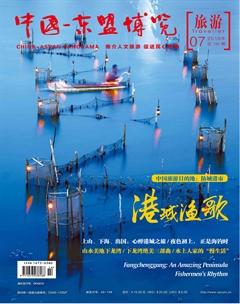An Ecological City
Huang Yuzhao
The year 2018 marks the 50th anniversary of the founding of Fangchenggang. Nowadays 50 years has passed, the city has been developed as one of Chinas most important ports and made great progress in industry. However, the city does not forget the environment and ecology. Golden camellias is ready to reach your eyes and touch your heart at any moment, clustered mangroves are standing bashfully in the shallow sea waiting for you to appreciate their beauty, and egrets are flapping their wings aiming to greet you. All these make Fangchenggang such an appealing and ecological tourist destination.
Fangchenggang: A land of abundance
Situated at the southwestern end of Chinas coastline, Fangchenggang, a coastal, frontier and port city, boasts an abundance of resources, some of which can be concluded as “five reds” and “five golds”. The “five reds” refer to red peanuts, red pitaya (dragon fruits), red sea duck eggs, red sweet potatoes and red wax apple. The “five golds” represent golden camellias, golden kumquats, golden glutinous rice, golden star anises and golden cinnamons. Developing the “five reds” and “five golds” industries has become one of the key sources of income in Fangchenggang, and also a way to promote its agricultural tourism.
Several labels can indicate the richness of Fangchenggang and the scarcity of its species. Golden camellia, listed as a first-class nationally protected plant, is reputed as the city flower of Fangchenggang. Golden camellia blossom will cover the whole mountains from December to next March. Apart from its ornamental value, golden camellia has many medicinal and research values as well. Fangchenggang has been the largest golden camellia planting base in China, and was renowned as the “home of golden camellia in China” in 2011.
In addition to golden camellia, Fangchenggang is also the hometown of mangroves and cinnamons. Mangrove is a type of tropical and subtropical coastal plant growing by the sea. It is also known as “coast guard” as it can form strong coastal protection forests against floods or tsunami. As you approach, you will see the branches and leaves of the mangroves coming out from the sea, as if there is a sense of standing on the top of the forests. Sometimes in foggy weather, the misty and drizzly ambience will make you feel like reveling in the joy in a fairyland of the distant mountains and close jungles. Shijiao Mangrove Reserve, located in Shijiao village, Jiangshan town of Fangchenggang, is the third largest mangrove reserve in the world and the largest in China. Wetland mangroves are a crucial ecosystem on the earth, which play a significant role in protecting coasts, reducing pollution, and regulating climate. Unlike other nature reserves, Shijiao Mangrove Reserve only has a floating road built of wood that runs through the whole area, with the rest parts covered with verdant and dense mangrove forests.
Cinnamon also serves as a symbol of Fangchenggang. It is one of the three treasures of aromatic plants in Guangxi subtropical zone. According to historical records, there was a tradition of planting cinnamon in Guangxi as early as the Qin Dynasty (221-207 BC).
Egrets — emblem of Fangchenggang
Pleasant weather and comfortable environment are the premise of a livable city. Surrounded by huge mountains, gurgling streams, and boundless forests, Fangchenggang is endowed with both well-protected environment and fine weather.
The sound environment also provides a good habitat for several hundreds of animals, especially egrets. Witnessing the peaceful coexistence and harmony between man and egret, Fangchenggang has been nominated as “the home of egrets” due to its favorable temperature and humidity conditions, with various kinds and a large number of egrets gathering here. Egrets can be deemed as an ecological emblem of the city. The egrets can be categorized into two kinds according to their migratory habits — resident birds and migratory birds. The former will gather together breeding every March to July, and prefer living in surrounding or other subtropical regions at other times; the latter will fly back to the southern parts in October and to the north around next May. Interestingly, both of them choose Fangchenggang as their destination of migration.
Fangchenggang has built many ecological parks for egrets to breed and grow. Spring is the best time for people to appreciate this lovely creature. Every year, visitors from all corners of the country would rush here to take a look at the egrets, which are bold and have no fear of man. If you walk up to the viewing platform, the enchanting egrets are just in front of you: elder egrets carry bits of branches in their beaks to build nests while younger ones are crying piteously for food. Some egrets with long feathers will stand in the lush reeds, looking for food or gazing at the distance, beautiful and graceful. Sometimes they may fly up and down, romping around or chasing after each other above the jungles, or sometimes they just sleep serenely by their babies. A tour in these parks will never disappoint you. There are no crowds, skyscrapers or traffic jam, and all you need to do is just relax and immerse yourself in this beautiful image of harmony between man and nature.
Fangchenggang has been nominated as “the home of egrets” due to its favorable temperature and humidity conditions, with various kinds and a large number of egrets gathering here.

